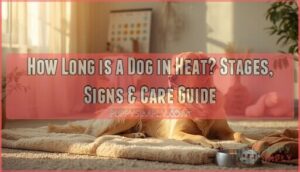This site is supported by our readers. We may earn a commission, at no cost to you, if you purchase through links.
Most female dogs experience their first heat cycle between six and twelve months of age, catching many new owners off guard. The average heat cycle lasts about two to three weeks, though the fertile window is shorter than you might expect.
Your dog’s breed, size, and overall health all influence how long she’ll stay in heat and how often the cycle repeats.
Understanding these patterns helps you prepare for the behavioral shifts, physical changes, and extra care she’ll need during this time. Recognizing the stages of the heat cycle lets you manage her comfort, prevent unplanned pregnancies, and spot any warning signs that require veterinary attention.
Table Of Contents
- Key Takeaways
- How Long is a Dog in Heat?
- What Are The Stages of a Dog’s Heat Cycle?
- How Often Do Dogs Go Into Heat?
- When Do Dogs First Go Into Heat?
- What Are The Signs a Dog is in Heat?
- How Long Does a Dog in Heat Bleed?
- Do All Dogs Experience The Same Heat Length?
- How to Care for a Dog in Heat
- Can a Dog Be in Heat Without Bleeding?
- When to Consult a Veterinarian About Heat
- Frequently Asked Questions (FAQs)
- How long is a dog in heat?
- How often does a dog have a heat cycle?
- When does heat start in dogs?
- What happens during a dog’s heat cycle?
- How long is a female dog receptive to heat?
- Does a female dog have a heat cycle?
- How can I tell if my dog is in heat if there is no visible discharge?
- What are the risks associated with a dog’s heat cycle?
- How can I prepare my home and routine for my dog’s heat cycle?
- Can you spay a dog during heat?
- Conclusion
Key Takeaways
- Most dogs stay in heat for 2 to 3 weeks total, with the fertile window lasting about 9 days on average, though breed size, age, and health can make cycles shorter or longer.
- Your dog’s heat cycle includes four stages—proestrus (bloody discharge and swelling), estrus (receptive to mating), diestrus (progesterone peak), and anestrus (resting phase)—each bringing distinct physical and behavioral changes you’ll need to manage.
- Silent heats occur when your dog experiences hormonal changes and can still get pregnant despite showing minimal or no visible bleeding, making close observation and vet consultation essential for accurate detection.
- Watch for warning signs like excessive bleeding beyond 21 days, foul-smelling discharge, severe pain, or lethargy, as these can indicate serious infections like pyometra that require immediate veterinary care.
How Long is a Dog in Heat?
If your dog is going into heat for the first time, you’re probably wondering how long this will last. The answer isn’t one-size-fits-all, since every dog experiences heat a bit differently.
Let’s look at what you can expect for duration, the typical range you might see, and what factors can make your dog’s cycle shorter or longer.
Average Duration of a Heat Cycle
Most dogs stay in heat for about 2 to 3 weeks, combining the proestrus and estrus phases of the canine estrous cycle. During this fertile window, your dog’s body goes through significant hormonal changes that affect her behavior and physical condition.
Here’s what you need to know about the heat cycle:
- Proestrus generally lasts around 9 days, with bloody discharge and vulvar swelling
- Estrus averages 7 to 10 days when your dog is receptive to mating
- The total estrus cycle duration ranges from 12 to 21 days in most cases
- Hormonal influence drives behavioral shifts throughout each phase
- Individual variation means some dogs experience shorter or longer cycles
If a website has issues, technical teams are often working to resolve them.
Range of Heat Cycle Lengths
While the typical heat cycle spans 2 to 3 weeks, your dog’s reproductive cycle might look quite different. Estrus phase length varies dramatically—from just 3 days to over 3 weeks in some cases. Proestrus duration can range anywhere from a few days to nearly a month. Understanding the hormonal changes during these phases is key to predicting fertility.
| Cycle Component | Typical Range |
|---|---|
| Proestrus | 6-11 days |
| Estrus Phase | 3-21 days |
| Total Heat Season | 14-28 days |
| Between Cycles | 5-11 months |
| Silent Heats | Variable, often undetected |
Breed differences and individual variation explain why your neighbor’s Chihuahua experiences noticeably shorter cycles than your Mastiff. Some dogs even have silent heats with minimal bleeding, making the canine estrous cycle harder to track.
Factors Affecting Heat Duration
You’ll notice several elements shape how long your dog stays in heat. Breed size plays a major role—smaller dogs often cycle faster than giant breeds. Age influence matters too, since younger and older females frequently show irregular patterns.
- Health Impact: Thyroid issues or poor nutrition can shorten or extend the estrus period
- Environment Effects: Stress and seasonal changes may alter hormonal changes
- Genetic Factors: Your dog’s lineage determines her baseline fertility cycle length
What Are The Stages of a Dog’s Heat Cycle?
Your dog’s heat cycle isn’t just one event—it’s actually a series of four distinct stages that unfold over several months. Each stage brings different physical changes and behaviors, so knowing what to expect helps you care for your dog more confidently.
Let’s break down what happens during proestrus, estrus, diestrus, and anestrus.
Proestrus Phase and Duration
Proestrus marks the beginning of your dog’s heat cycle, usually lasting 7 to 10 days but ranging from 3 to 27 days. You’ll notice vulvar swelling and blood-tinged discharge as estrogen levels rise. Your dog will attract male dogs during this phase but won’t accept mating attempts.
Behavioral indicators include restlessness and frequent urination, reflecting the hormonal changes preparing her body for fertility.
Estrus Phase and Duration
Estrus, often called “standing heat,” arrives when your dog becomes fertile and receptive to mating. This phase lasts an average of 9 days, though the range spans 2 to 24 days depending on the individual. Hormone levels shift as estrogen falls and progesterone rises, triggering ovulation around day 2.
During estrus, you’ll observe:
- Discharge changes from bloody to straw-colored or pink
- Behavioral receptivity with tail flagging when males approach
- Ovulation timing creates a fertile window lasting about 5 days
- Increased marking and urination signaling reproductive status
The canine estrous cycle peaks here, making prevention of unwanted mating essential.
Diestrus and Anestrus Phases
After estrus ends, diestrus begins—a 60-day phase where progesterone peaks regardless of pregnancy. Your dog won’t accept males now, and vulvar swelling fades. Some dogs show false pregnancy signs like mammary swelling or nesting.
Next comes anestrus, lasting 4 to 6 months. This resting phase allows uterine involution and hormone reset, preparing the canine estrous cycle to begin again.
How Often Do Dogs Go Into Heat?
Understanding how often your dog goes into heat helps you plan ahead and manage her care throughout the year. Most dogs cycle every six to eight months, but this isn’t a one-size-fits-all timeline.
Several factors influence when and how frequently your dog experiences her heat cycle.
Typical Heat Cycle Frequency
Most dogs go into heat roughly twice a year, with an average interval of six to seven months between cycles. This reproductive cycle, also known as estrus, repeats throughout your dog’s life since canines don’t experience menopause. Heat cycle intervals can range from five to eleven months, and you’ll notice this pattern stabilizes after the first few cycles.
Population-wide trends show this biannual frequency holds true across diverse environments and living conditions. Young dogs often start with irregular heat cycles before settling into a predictable rhythm. Keep in mind that your dog’s specific timing may vary slightly.
Breed and Age Influences
Your dog’s breed and age play major roles in how often she’ll experience estrus. Small breeds like Chihuahuas usually cycle two to three times yearly, while large breeds such as Great Danes may only go into heat once per year. Medium-sized dogs usually fall in between, cycling twice annually.
Age also matters—younger dogs often have irregular cycles during their first heat before establishing a predictable pattern. Senior dog heats may occur less frequently with longer intervals between cycles, though dogs don’t experience menopause.
Breed size frequency directly impacts the proestrus, estrus, diestrus, and anestrus phases your dog will experience throughout her life.
When Do Dogs First Go Into Heat?
Timing your dog’s first heat cycle isn’t an exact science, but knowing when to expect it can help you prepare. The age varies quite a bit depending on factors like breed size and individual development.
Here’s what influences when your dog will experience her first heat.
Average Age for First Heat
Your female dog will usually experience her first heat cycle somewhere between 6 and 12 months of age, though this timeline isn’t set in stone. Breed size plays a significant role in when puberty arrives, and understanding these patterns helps you prepare for your dog’s reproductive health journey.
Here’s what you can expect based on your dog’s size:
- Small breeds usually enter their first estrus between 6 and 7 months
- Medium breeds usually start between 7 and 9 months
- Large breeds often begin around 12 to 18 months
- Giant breeds may not experience proestrus until 18 to 24 months
- Early heat can occur as young as 4 months in rare cases
Genetic factors and nutritional impact also influence timing.
Breed-Specific Differences
Your dog’s breed is one of the strongest predictors of when her first heat will arrive, and understanding these patterns helps you prepare. Toy breeds like Chihuahuas can begin their breeding cycle as early as 4 months, while giant breeds such as Mastiffs may not experience their first heat until 24 months. Medium breeds usually fall between these extremes, starting around 8 to 12 months.
This wide variation affects not just timing but also heat frequency and cycle length throughout her life. These breed-specific differences in canine reproduction reflect how body size influences hormonal development and breeding and pregnancy in dogs.
What Are The Signs a Dog is in Heat?
Knowing when your dog is in heat isn’t always obvious, especially if this is her first cycle. Some signs are physical and easy to spot, while others show up in how she acts or behaves around other dogs.
Let’s walk through the most common indicators you’ll notice during this time.
Physical Symptoms
Your dog’s body gives clear signals during her heat cycle. Watch for these physical changes:
- Vulvar swelling: The vulva enlarges noticeably, often before any bleeding appears
- Vaginal discharge: Blood-tinged fluid that may shift from red to watery pink
- Nipple enlargement: Swelling from hormonal changes, unrelated to pregnancy
- Excessive licking: She’ll clean herself frequently to manage discharge
- Urination habits: More frequent marking to signal availability
Behavioral Changes
Beyond the physical signs, your dog’s personality may shift dramatically. Restlessness causes pacing and difficulty settling, while Hyperactivity Triggers can make her seem wired or unusually energetic.
You’ll notice Anxiety Symptoms like excessive whining, increased clinginess, or attempts to escape. Some dogs experience Social Withdrawal and Emotional Instability, alternating between seeking affection and snapping at other pets.
These hormonal changes in dog behavior and body language are completely normal during her cycle.
Vaginal Discharge and Bleeding
The most visible sign you’ll see is vaginal discharge, which starts as bright red bleeding during proestrus. This bleeding usually lasts 7 to 10 days, though some dogs bleed longer. As your female dog moves into estrus, the discharge often lightens to pink or straw-colored.
Bleeding Duration and Discharge Patterns vary widely, so tracking her individual reproductive cycle helps you recognize what’s normal for her Canine Hygiene needs.
How Long Does a Dog in Heat Bleed?
Bleeding is one of the most recognizable signs your dog is in heat, but it doesn’t last the entire cycle. The amount and appearance of the discharge changes as your dog moves through different stages.
Understanding when bleeding starts and when it tapers off can help you know what to expect during each phase.
Bleeding in Proestrus
Most of the visible bleeding you’ll notice happens during the proestrus phase, which generally lasts 7 to 10 days. This initial stage kicks off your dog’s heat cycle, and the discharge usually starts bright red before gradually becoming lighter and more watery. The amount varies depending on your dog’s size—larger breeds tend to show heavier bleeding, while smaller dogs may have minimal discharge.
Key things to watch for during proestrus:
- Bleeding can range from 3 to 17 days, though 9 days is most common
- Some dogs groom themselves so well you might barely notice the discharge
- Prolonged bleeding beyond 17 days signals a potential problem requiring veterinary attention
Changes During Estrus
As estrus begins, hormonal fluctuations transform the discharge from bright red to a straw-colored or pink-tinged fluid. This physiological change signals peak fertility timing and marks a critical shift in your dog’s reproductive cycle. The bleeding becomes lighter and less frequent, though your dog’s vulva remains swollen.
Here’s what changes during the estrus phase:
| Phase Characteristic | Proestrus | Estrus |
|---|---|---|
| Discharge Color | Bright red | Straw/pink |
| Discharge Volume | Heavy | Light |
| Receptivity to Males | None | High |
| Behavioral Shifts | Restless | Flirtatious |
| Fertility Window | Not fertile | Peak fertility |
These estrus symptoms indicate that your dog’s reproductive health is progressing normally.
Do All Dogs Experience The Same Heat Length?
No, not all dogs experience the same heat length. Several factors influence how long a dog stays in heat, including her breed size, age, and overall health.
Let’s look at the key differences that affect heat cycle duration.
Differences by Breed Size
Your dog’s breed size plays a major role in how long she stays in heat and how often it happens. Small breeds tend to cycle more frequently, while giant breeds take their time. Here’s what you need to know about Size Impact Factors:
- Small breeds experience heat cycles averaging 10–14 days, usually 2–3 times per year, with their first heat around 6 months
- Large breeds have longer heat cycles of 18–21 days, going into heat just 1–2 times yearly, starting around 9–18 months
- Giant breeds face the biggest Giant Breed Challenges, cycling once yearly for 2–4 weeks, often not starting until 18–24 months
Understanding Breed Size Variance helps you prepare for your female dog’s reproductive cycle.
Impact of Age and Health
Your dog’s hormonal shifts change dramatically as she ages. Young females often have irregular dog heat cycles at first, but these stabilize over time. Senior care becomes essential after age seven, when reproductive changes affect cycle length and consistency.
Older female dogs may experience longer intervals between heats or shorter, less obvious cycles due to declining hormone levels. Health risks increase with age, particularly infections like pyometra.
Poor reproductive health in dogs—whether from obesity, thyroid problems, or chronic illness—can disrupt normal patterns at any age. Age factors and overall canine reproductive health directly impact dog health and wellness during heat.
How to Care for a Dog in Heat
Caring for a dog in heat doesn’t have to be overwhelming once you know what to expect. Your main job is to keep her comfortable, prevent unwanted pregnancies, and maintain a clean home during this time.
Here’s what you need to focus on to make the process easier for both of you.
Managing Hygiene and Cleanliness
Ever noticed how a little planning can save your floors and your dog’s comfort during heat? Diapering techniques, like using dog diapers and pads, help manage vaginal discharge and vulvar swelling. Gentle vulva cleaning with pet-safe wipes prevents infection.
For odor control, wash bedding often and limit access to carpets. Environmental hygiene and infection prevention are key for female dog health and heat cycle management.
Preventing Unwanted Mating
Did you know that leashing and direct supervision prevent over 95% of accidental matings during your dog’s heat cycle? Physical barriers—like secure fences—are a must, but spaying remains the best approach for pregnancy prevention.
Owner education, behavioral strategies, and pharmaceutical options play supporting roles. Spaying and neutering protect your dog and offer lasting health benefits and peace of mind.
Comfort and Emotional Support
Your dog’s emotional well-being matters just as much as her physical health during heat. Hormonal shifts can trigger anxiety, restlessness, and mood swings, so supporting her through this phase requires thoughtful pet care and animal behavior awareness.
Here’s how to provide comfort:
- Create a safe space in a quiet, low-traffic area with her favorite bed and toys
- Maintain routine maintenance by keeping feeding times and leashed walks consistent
- Offer calming aids like CBD treats or gentle music to ease stress
- Practice reading language by watching her body cues—some dogs crave cuddles while others need solitude
Mental stimulation through puzzle toys or scent work helps channel pent-up energy. Gentle brushing provides soothing contact. Remember, dog behavior and training principles still apply; positive reinforcement works wonders. If you notice prolonged distress or unusual behaviors, consult your veterinarian.
Proper animal welfare means recognizing that pet ownership includes emotional support, not just meeting basic needs. Your attention and understanding can make this challenging time much easier for your companion.
Can a Dog Be in Heat Without Bleeding?
Yes, some dogs can go into heat without obvious bleeding, a phenomenon known as a “silent heat.” During a silent heat, your dog still experiences hormonal changes and can become pregnant, but the typical physical signs aren’t as noticeable.
Understanding what silent heat looks like and how to spot the subtle clues will help you manage your dog’s reproductive cycle more effectively.
Silent Heat Explained
Yes, your dog can experience a reproductive cycle without the typical bleeding you’d expect. This phenomenon, called silent heat, happens when hormone levels shift and ovulation occurs, but the usual external signs—like vulvar swelling or vaginal discharge—simply don’t show up.
It’s not a health problem, just a variation in how some dogs express their heat cycle. Despite the absence of visible fertility signs, your dog can still get pregnant during this time.
That’s why veterinary guidance and heat detection through progesterone testing become essential tools for dog heat cycle management, especially if you’re facing breeding challenges.
Recognizing Subtle Signs
When physical signs aren’t obvious, you’ll need to watch for subtler indicators. Some females show minimal vulvar swelling or almost no vaginal discharge, making silent heat detection tricky without close attention.
Look for these behavioral indicators:
- Slight clinginess or increased attention-seeking
- Mild restlessness or small changes in appetite
- More frequent licking of the vulvar area
Male dogs will still pick up pheromone cues even when visible signs are absent. If intact males suddenly show interest in your female—increased barking, marking, or hovering—that’s your signal.
Environmental monitoring combined with regular physical checks helps you catch what might otherwise go unnoticed during your dog’s heat cycle.
When to Consult a Veterinarian About Heat
Most dogs go through heat cycles without any issues, but sometimes things don’t go as expected. Knowing when to call your vet can help you catch problems early and keep your dog healthy.
Watch for these warning signs that something might need medical attention.
Abnormal Heat Cycle Lengths
Understanding normal heat cycle variations helps you recognize when something’s off. A typical heat cycle lasts two to four weeks, but abnormal cycling can signal reproductive issues.
If your dog’s heat extends beyond 21 days without ovulation, or if she hasn’t cycled within 18 months after her last heat, you’re looking at a potential hormone imbalance. Silent heats, where she’s fertile but shows no signs, and split heats that stop and restart are also red flags.
Canine fertility problems, ovarian cysts, or malnutrition can disrupt your dog’s reproductive cycle, so don’t wait to contact your vet if you notice these patterns.
Signs of Health Concerns During Heat
Beyond irregular timing, watch for warning signs that demand immediate veterinary care. Excessive bleeding or discharge lasting longer than normal points to infection risks like pyometra, a life-threatening uterine infection common in unspayed females. If your dog shows severe pain, fever, lethargy, or foul-smelling discharge, don’t hesitate to call your vet.
Emergency signs like extreme vulvar swelling or complete loss of appetite signal heat cycle complications that need professional attention.
Health monitoring during each cycle protects your dog from female dog health issues that can escalate quickly without prompt veterinary care for dogs.
Frequently Asked Questions (FAQs)
How long is a dog in heat?
Most female dogs stay in heat for 12 to 20 days total. The fertile window, or true estrus phase, usually lasts about 9 days, though it can range from 3 to 21 days.
How often does a dog have a heat cycle?
Most dogs go into heat twice a year, roughly every six to seven months. Smaller breeds often cycle more frequently, while larger breeds may only experience one heat cycle annually.
When does heat start in dogs?
Your female dog’s first heat cycle generally begins between 6 and 24 months of age. Breed size affects timing greatly—smaller breeds often start earlier, while giant breeds may experience delayed first heat until two years old.
What happens during a dog’s heat cycle?
Your dog’s reproductive cycle involves hormone fluctuations across four distinct cycle phases: proestrus, estrus, diestrus, and anestrus. Each stage affects her reproductive organs and fertility window, and triggers specific behavioral changes throughout the heat cycle.
How long is a female dog receptive to heat?
During estrus, your female dog stays receptive to males for about 9 days on average, though this fertility window can range from 2 to 24 days depending on individual factors.
Does a female dog have a heat cycle?
Yes, your female dog has a heat cycle, also called the estrous cycle. This is a natural part of reproductive health in dogs, driven by hormonal changes that prepare her body for potential breeding.
How can I tell if my dog is in heat if there is no visible discharge?
Even without discharge, you can spot silent heat signs through behavioral shifts—restlessness, increased urination, male dog interest, or vulvar swelling.
Veterinary guidance with hormone testing confirms fertility indicators when subtle symptoms appear.
What are the risks associated with a dog’s heat cycle?
Unspayed females face serious reproductive health risks, including pyometra—a life-threatening uterine infection affecting up to 25% of dogs.
Heat cycle abnormalities, mammary tumors, and reproductive complications also increase without spaying, requiring vigilant veterinary monitoring.
How can I prepare my home and routine for my dog’s heat cycle?
Most female dogs cycle twice yearly, so preparation matters.
Stock up on doggy diapers, secure your yard to prevent mating, and schedule vet monitoring to track vulvar swelling and behavioral changes throughout her heat.
Can you spay a dog during heat?
While your dog can be spayed during her heat cycle, veterinarians generally recommend waiting. Increased blood flow to reproductive organs raises spay risks, complicating the surgery and potentially extending recovery time.
Conclusion
Picture your dog curled beside you, restful and content once her cycle passes. Knowing how long a dog is in heat—and recognizing each stage—equips you to support her through the discomfort, keep her safe, and prevent surprises.
Watch for changes in behavior and discharge, maintain her hygiene, and don’t hesitate to call your veterinarian if something feels off. Your awareness turns uncertainty into confident care, giving her exactly what she needs when she needs it most.
- https://vet.tufts.edu/people/faculty/meera-gatlin
- https://danikk.com/dr-frances-o-smith
- https://veterinarypartner.vin.com/default.aspx?pid=19239&id=11506649
- https://www.dvm360.com/view/canine-estrous-cycle-and-ovulation-proceedings
- https://www.vet.cornell.edu/departments-centers-and-institutes/riney-canine-health-center/canine-health-information/dog-estrous-cycles


















